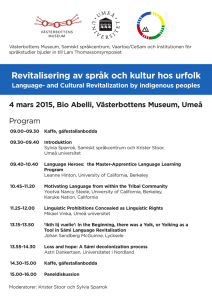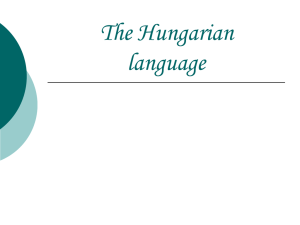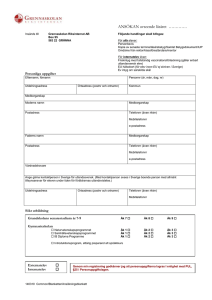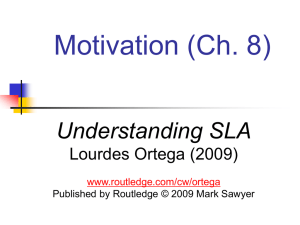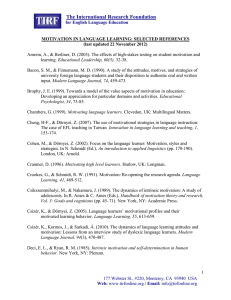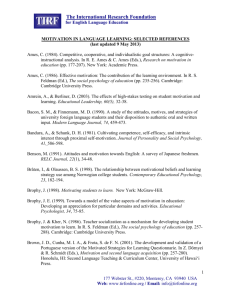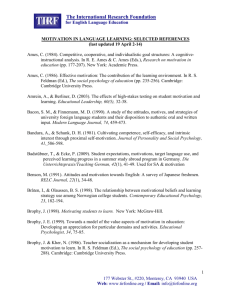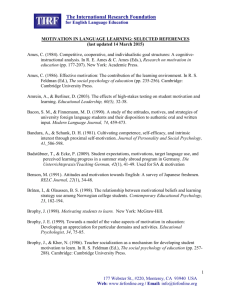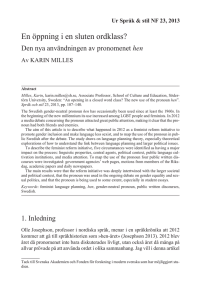Bibliography
advertisement
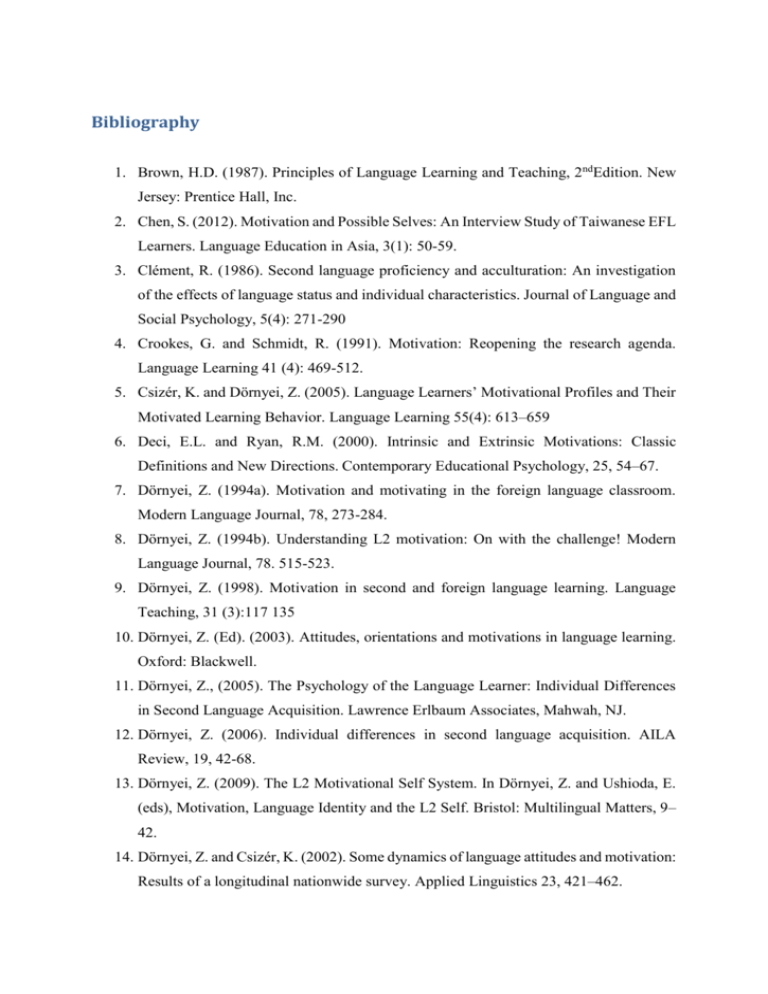
Bibliography 1. Brown, H.D. (1987). Principles of Language Learning and Teaching, 2ndEdition. New Jersey: Prentice Hall, Inc. 2. Chen, S. (2012). Motivation and Possible Selves: An Interview Study of Taiwanese EFL Learners. Language Education in Asia, 3(1): 50-59. 3. Clément, R. (1986). Second language proficiency and acculturation: An investigation of the effects of language status and individual characteristics. Journal of Language and Social Psychology, 5(4): 271-290 4. Crookes, G. and Schmidt, R. (1991). Motivation: Reopening the research agenda. Language Learning 41 (4): 469-512. 5. Csizér, K. and Dörnyei, Z. (2005). Language Learners’ Motivational Profiles and Their Motivated Learning Behavior. Language Learning 55(4): 613–659 6. Deci, E.L. and Ryan, R.M. (2000). Intrinsic and Extrinsic Motivations: Classic Definitions and New Directions. Contemporary Educational Psychology, 25, 54–67. 7. Dörnyei, Z. (1994a). Motivation and motivating in the foreign language classroom. Modern Language Journal, 78, 273-284. 8. Dörnyei, Z. (1994b). Understanding L2 motivation: On with the challenge! Modern Language Journal, 78. 515-523. 9. Dörnyei, Z. (1998). Motivation in second and foreign language learning. Language Teaching, 31 (3):117 135 10. Dörnyei, Z. (Ed). (2003). Attitudes, orientations and motivations in language learning. Oxford: Blackwell. 11. Dörnyei, Z., (2005). The Psychology of the Language Learner: Individual Differences in Second Language Acquisition. Lawrence Erlbaum Associates, Mahwah, NJ. 12. Dörnyei, Z. (2006). Individual differences in second language acquisition. AILA Review, 19, 42-68. 13. Dörnyei, Z. (2009). The L2 Motivational Self System. In Dörnyei, Z. and Ushioda, E. (eds), Motivation, Language Identity and the L2 Self. Bristol: Multilingual Matters, 9– 42. 14. Dörnyei, Z. and Csizér, K. (2002). Some dynamics of language attitudes and motivation: Results of a longitudinal nationwide survey. Applied Linguistics 23, 421–462. 15. Dörnyei, Z. and Ottó, I. (1998). Motivation in action: A process model of L2 motivation. Applied Linguistics, 4, 43–69. 16. Dörnyei, Z. and Ushioda, E. (eds) (2009). Motivation, Language Identity and the L2 Self. Bristol: Multilingual Matters. 17. Dörnyei, Z., and Ushioda, E. (2011). Teaching and researching motivation (2nd ed.). Harlow: Longman. 18. Dörnyei, Z., Csizér K., and Németh N. (2006) Motivation, Language Attitudes and Globalization: A Hungarian Perspective. Clevedon: Multilingual Matters 19. Gardner, R.C. (1985). Social Psychology and Second Language Learning: The Role of Attitudes and Motivation. London. Edward Arnold Ltd 20. Gardner, R.C. (2001). Integrative motivation and second language acquisition. a. http://publish.uwo.ca/~gardner/docs/caaltalk5final.pdf 21. Gardner, R. (2006). Motivation and Second Language Acquisition. http://publish.uwo.ca/~gardner/docs/SPAINTALK.pdf 22. Gardner, R.C. and Lambert, W.E. (1972). Attitudes and Motivation in Second Language Learning. Rowley: Newbury House Publication, 23. Jelovčić, I. (2010). Strani jezik struke-analiza stavova studenata. Metodika, 20 (11): 4455. 24.Kolić-Vehovec S., Pečjak S., and Zubković-Rončević B. (2009). Spolne razlike u (meta) kognitivnim i motivacijskima čimbenicima razumijevanja teksta adolescenata u Hrvatskoj i Sloveniji. Suvremena psihologija, 12 (2): 229-242 25. Kormos J., Kiddle T., and Csizér K. (2011). Systems of Goals, Attitudes, and Selfrelated Beliefs in Second-Language-Learning Motivation. Applied Linguistics, 32 (5): 495-516. 26. Kubanyiova, M. (2009). Possible selves in language teacher development. In Dörnyei, Z. and Ushioda, E. (eds) Motivation, Language Identity and the L2 Self. Bristol: Multilingual Matters: 314–332. 27. Paiva, V.L.M. de O. e (2011). Identity, Motivation and Autonomy in Second Language Acquisition from the Perspective of Complex Adaptive Systems. In: Murray, G. et al. Identity, Motivation and Autonomy in Language Learning. Bristol: St Nicholas House, 2011. 57-69 28. Mihaljević, Djigunović, J. (1995). Research on the affective domain of EFL learning: a study of motivation. Studia Romanica et Anglica Zagrabiensia, 42, 257-267. 29. Mihaljević, Djigunović, J. (1996). Learner motivation as a source of variance in attitudes, effort and achievement. Studia Romanica et Anglica Zagrabiensia, 41,211223. 30. Mihaljević, Djigunović, J. and Bagarić, V. (2007).A Comparative Study of Attitudes and Motivation of Croatian Learners of English and German. Studia Romanica et Anglica Zagrabiensia, 52, 259-281. 31. Murray, G., Gao X., and Lamb T. (2011). Identity, Motivation and Autonomy in Language Learning. Bristol: St Nicholas House, 57-69 32. Noels, K.A., Pelletier, L.G., Clément, R., and Vallerand, R.J. (2000). Why are you learning a second language? Motivational orientations and self-determination theory. Language Learning, 50:1, 57-85 33. Oxford, R. and Shearin, J. (1994). Language Learning Motivation: Expanding the Theoretical Framework. The Modern Language Journal, 78 (1):12–28 34. Papi, M. (2010). The L2 motivational self system, L2 anxiety, and motivated behavior: A structural equation modeling approach. System, 38, 467-479. 35. Root, E. (1999). Motivation and Learning Strategies in a Foreign Language Setting: A Look at a Learner of Korean. CARLA, Minneapolis: University of Minnesota, 1-74 36. Ryan, S. and Dörnyei, Z. (2013). The long-term evolution of language motivation and the L2 self. In A. Berndt (Ed.), Fremdsprachen in der Perspektive lebenslangen Lernens. Frankfurt: Peter Lang, 89-100 37. Suzuki, M. (2011). Ideal L2 Selves of Japanese English Learners at Different Motivational Level. The bulletin of the Graduate School, Soka University, 329-351 http://libir.soka.ac.jp/dspace/bitstream/10911/3540/1/dk33-329.pdf 38. Taguchi T., Magid M., and Papi M. (2009). The L2 Motivational Self System among Japanese, Chinese and Iranian learners of English: A comparative study. In Z. Dörnyei and E. Ushioda (eds) Motivation, Language Identity and the L2 Self. Multilingual Matters, Bristol, 66–97. 39. Tremblay, P. and Gardner, R.C. (1995). Expanding the motivation construct in language learning. The Modern Language Journal, 79 (4): 505-518.
